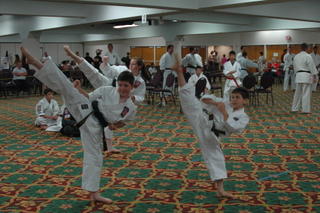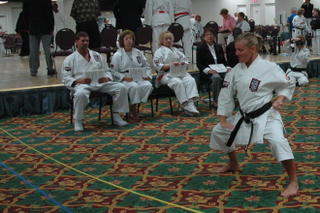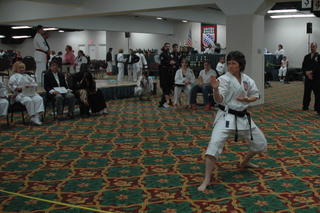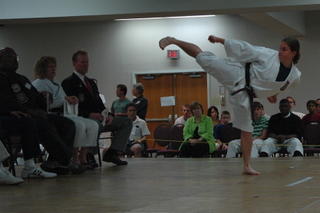Some recent perusing of the websites of various martial arts schools and organizations turned up many instances of "loyalty" and "family" as being values taught and held dear by many martial artists. In fact, these are often referred to as being foundational values. The history of the martial arts is full of blood oaths of loyalty, of practitioners being inducted into families, of martial artists being willing to lay down their lives for their dojo mates.
That was, of course, another day and time ♠ even if some modern day black belt ceremonies still involve oaths and tattoos.
I am not one for oaths and vows and binding covenants. The last vows I took were during my marriage ceremony. I do not take these things lightly. I agree with Jesus' words, "Let your yes be yes and your no be no." I am thankful that Soke did not require any vows of allegiance from me during my black belt ceremony.
At the same time, the lack of loyalty and family sense among many martial artists disturbs me. I don't expect beginners in the martial arts to have a sense of loyalty; many of them are still "trying out" the martial arts. They are products of our American culture, which is more and more consumer-oriented and driven by felt needs. As long as the martial arts class "meets their needs", as long as it is fun, they will come.
For quite a while, "family" has been listed as one of the core values of our dojo. I've stressed the importance of family, not only our immediate family, but our dojo family, and our extended Keichu family. I sense, when I talk about these things, that most of my students think I am a bit odd to go on and on about "family members" they have never met. So what if this guy also does the same art in some other dojo somewhere? What is that to them?
One former student went so far as to say, "If I hear that guy's name one more time, I'm gonna scream!", referring to a Keichu instructor and impressive competitor. When there is exciting news to be shared about someone within the Keichu family, I share it. That's what family does. This student was simply annoyed. She thought our dojo should be more about her than about people she'd never even met. She didn't understand her place in the grand scheme of things. She didn't understand that this young man was her sempai, her senior within Keichu, and that she owed him her respect.
But, then again, she didn't see us as family either.
Students come and go. When do they actually become family? Is it when they first put their feet on our floor? Is it when they sew on their Keichu patch? Is it when they advance to a certain rank? Or is it when they recognize the kinship and bond that should exist among all Keichu practitioners?
And what about loyalty? What does it require of us? Does it fit within today's martial arts community, where too many students view martial arts simply as an alternative to fitness centers or team sports?
I don't need loyalty oaths to bind me to Keichu-Do. I don't need vows to recognize that those who train under the banner of "Keichu" are my brothers, sisters, uncles, aunts, sons, daughters, and cousins, and that Soke is our father. That is what Keichu has become to me. It is my family. It is my way of life. It is my home.
All of this, I'm sure, sounds odd to beginners. "But it's just a martial arts class!" I can hear them say. Well, yes...for you. For me, and for many others, it is something far more.
I've been rethinking this whole "core value" thing, trying to put into words and distill the core values of Keichu that were handed down to me. Something seemed a bit amiss with the list we've been working from in our dojo. I ended up working on a new list, which at first was almost endlessly lengthy, echoing the Keichu Character Traits that we studied when I was coming up through the ranks and almost everything I could remember Soke emphasizing in his talks at the end of class. But who wants to be overwhelmed by two pages of "core values"? What values are really at the core of what Soke teaches?
This is what I finally came up with:
- Dedication (of course...that almost goes without saying!)
- Discipline
- Respect
- Honor
- Humility
- The Keichu Attitude
Wait a moment! What happened to loyalty and family? Ah, but that is what dedication and respect and honor and, in fact, all the core values are about. Loyalty and family are but a part of those values, an important part, but just a part.
I believe that the bonds of family are forever. It is a great privilege to be part of the Keichu family. May all of us grow in dedication, discipline, respect, honor, humility, and the Keichu attitude. May we be worthy of the name Keichu.






























